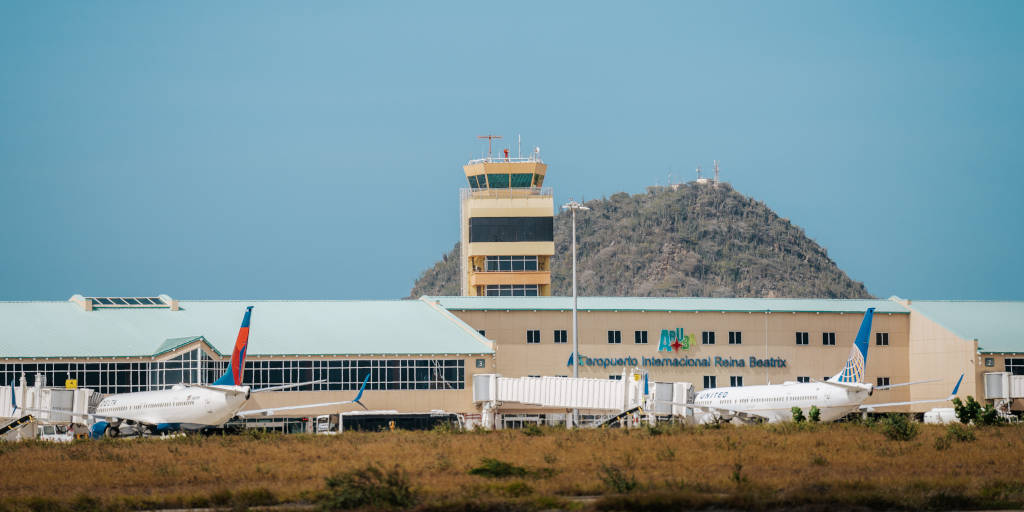Source: Aruba Airport

- Processing a total of 803,287 Passengers
Aruba Airport Authority N.V. (AAA) is proud to announce that it has achieved record-breaking passenger numbers in the first half of 2024. The airport processed a total of 803,287 revenue generating passengers, marking an all-time high compared to the same period in previous years and reflecting a 19% increase, including 2,330 passengers departing from our general aviation terminal (JET-TNCA), over the same period last year.
These numbers reinforce Aruba Airport’s status as a regional leader in the aviation industry and highlight Aruba’s continued popularity, particularly among North American visitors who represent 77% of our main traffic. This reflects a 1% decrease for the US market compared to previous years as AUA Airport continues its objective of diversifying tourism, aligning with the goals of the Aruba Tourism Authority and the Ministry of Tourism. While the USA leads with 73% of the market share, Canada represents 4%, Latin America & the Caribbean 14%—an increase of 2% compared to the previous year, further committing to the objective of diversifying the market—Europe 4%, and the Dutch Caribbean 4%.
Flight departure and load factors
During the first half of 2024, Aruba Airport facilitated 26 airlines, connecting Aruba to over 30 cities with 45 non-stop services. This period saw approximately 14,000 commercial aircraft movements (arrivals and departures), representing an 18% increase compared to the same period last year. At the JET-TNCA terminal, approximately 1,600 aircraft movements were handled during this same period.
An average load factor (the number of seats occupied on board an aircraft) of 87.9% was reported in the first half of 2023, while for 2024, an average load factor of 84.8% was reached. This slight decrease is attributed to the increased seat capacity due to new routes and additional flight frequencies. Notably, North America saw a 26% increase in seat capacity compared to the same period last year, and Latin America experienced a 46% growth.
New Routes and Additional Frequencies:
- LATAM Airlines: Due to great demand, LATAM Airlines will add a flight on Mondays to and from Lima, Peru. Starting July 2024, LATAM flies four times a week to Aruba on Mon-Thu-Sat-Sun, and starting October 2024, LATAM will fly five times a week to Aruba on Mon-Tues-Thu-Sat-Sun.
- Avianca: Brings the most Latin American visitors to Aruba on fifteen weekly flights, including four new flights from Medellin on Mon-Wed-Fri-Sun that commenced June 2nd. These flights not only serve direct routes but also offer important connections to other destinations within the network of Avianca, most importantly in Latin America.
- Gol Airlines: Starting December 18, Gol Airlines will start a three-weekly direct flight to São Paulo, Brazil. The newly added Gol flight brings the total airlift to the LATAM region to 32 weekly flights, a record high, connecting Aruba to the four major hubs of this continent: Bogotá, Panama, Lima, and São Paulo.
- Delta Air Lines: Starting December 20, Delta is bringing back its Minneapolis connection with two weekly flights and will also increase the number of flights out of New York (JFK), Boston, and Atlanta this winter season.
While the demand for Aruba continues to grow, positively impacting the local economy, we must also continue to strive to ensure Aruba Airport continues to work to better serve the increasing number of passengers. The ongoing project, known as Gateway 2030, represents a significant investment in modernizing and innovating Queen Beatrix Airport to overcome capacity constraints and deliver a world-class airport experience
In June, Aruba Airport celebrated the delivery of the prestigious Gateway 2030 project Phase 1A, which is currently in the testing phase and scheduled to be operational in 2025. Aruba Airport’s Gateway 2030 Phase 1A project features the brand-new US Departures terminal. Set to become operational in early 2025, this state-of-the-art facility includes an advanced baggage handling system designed to enhance efficiency and streamline the travel experience for passengers heading to the United States, eliminating three passenger processing checkpoints with this new and innovative system.
